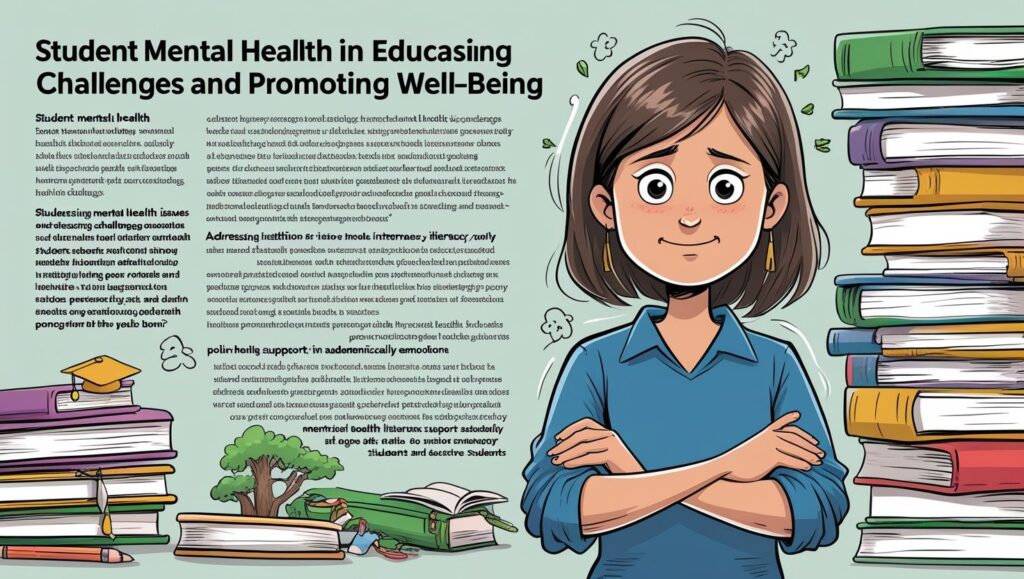Introduction
Student Mental Health in Education, Mental health is a critical aspect of overall well-being, particularly for students who are navigating the complexities of academic, social, and personal development. The importance of mental health in education has gained significant attention over the past few decades, with increasing recognition of the impact that mental health issues can have on students’ academic performance, social interactions, and long-term outcomes. This article explores the state of student mental health in education, focusing on the challenges students face, the role of educational institutions in addressing these issues, and the strategies that can be implemented to promote mental well-being among students.
The Prevalence of Mental Health Issues Among Students
Statistics and Trends
Mental health issues among students have been on the rise, with studies indicating a significant increase in the prevalence of conditions such as anxiety, depression, and stress. According to the American Psychological Association (APA), the rate of anxiety and depression among college students has increased steadily over the past decade, with more than 40% of students reporting symptoms of depression and over 60% experiencing overwhelming anxiety (APA, 2020). Similar trends have been observed in high school students, with the National Institute of Mental Health (NIMH) reporting that approximately 13% of adolescents aged 12-17 experience at least one major depressive episode each year (NIMH, 2021).
Contributing Factors
Several factors contribute to the rising prevalence of mental health issues among students. These include:
- Academic Pressure: The increasing demands of academic performance, including high-stakes testing, rigorous coursework, and competition for college admissions, can lead to significant stress and anxiety among students.
- Social Media and Technology: The pervasive use of social media and technology has been linked to increased feelings of loneliness, anxiety, and depression among students. The constant comparison to others and the pressure to maintain an online presence can exacerbate mental health issues.
- Financial Stress: Many students face financial pressures, including the rising cost of tuition, student loans, and the need to work part-time jobs while studying. These financial stressors can contribute to anxiety and depression.
- Family and Personal Issues: Students may also face challenges related to family dynamics, personal relationships, and identity issues, which can impact their mental health.
- Stigma and Lack of Awareness: Despite the increasing prevalence of mental health issues, stigma and lack of awareness often prevent students from seeking help. Many students may not recognize the signs of mental health problems or may fear judgment from peers and authority figures.

The Impact of Mental Health on Academic Performance
Academic Outcomes
Mental health issues can have a profound impact on students’ academic performance. Students experiencing anxiety, depression, or other mental health conditions may struggle with concentration, memory, and motivation, leading to lower grades and increased dropout rates. According to a study published in the Journal of Adolescent Health, students with mental health issues are more likely to have lower GPAs and are at a higher risk of dropping out of school (Eisenberg et al., 2009).
Attendance and Engagement
Mental health issues can also affect students’ attendance and engagement in school. Students may miss classes due to symptoms of depression or anxiety, or they may disengage from school activities and social interactions. This lack of engagement can further exacerbate feelings of isolation and contribute to a cycle of poor academic performance and declining mental health.
Long-Term Consequences
The impact of mental health issues on academic performance can have long-term consequences for students’ future opportunities. Poor academic performance can limit students’ access to higher education and career opportunities, perpetuating cycles of poverty and inequality. Additionally, untreated mental health issues in adolescence and young adulthood can lead to chronic mental health conditions in adulthood, further impacting individuals’ quality of life and ability to achieve their full potential.
The Role of Educational Institutions in Addressing Student Mental Health
Creating a Supportive Environment
Educational institutions play a crucial role in promoting student mental health by creating a supportive and inclusive environment. This includes fostering a culture of openness and acceptance, where students feel comfortable discussing their mental health concerns without fear of stigma or judgment. Schools and colleges can also implement policies and practices that prioritize student well-being, such as flexible attendance policies, mental health days, and access to counseling services.
Providing Access to Mental Health Services
Access to mental health services is essential for addressing student mental health issues. Educational institutions should ensure that students have access to qualified mental health professionals, including counselors, psychologists, and psychiatrists. This can be achieved through on-campus counseling centers, partnerships with local mental health organizations, and telehealth services. Additionally, schools and colleges should provide training for faculty and staff to recognize the signs of mental health issues and refer students to appropriate resources.
Promoting Mental Health Literacy
Mental health literacy refers to the knowledge and understanding of mental health issues, including how to recognize symptoms, seek help, and support others. Educational institutions can promote mental health literacy by incorporating mental health education into the curriculum, offering workshops and seminars, and providing resources such as brochures, websites, and hotlines. By increasing mental health literacy, schools and colleges can empower students to take charge of their mental well-being and reduce the stigma associated with mental health issues.
Implementing Preventive Measures
Preventive measures are essential for promoting mental health and well-being among students. These measures can include stress management programs, mindfulness and relaxation techniques, physical activity initiatives, and peer support programs. By implementing preventive measures, educational institutions can help students develop coping skills and resilience, reducing the likelihood of mental health issues arising in the first place.

Strategies for Promoting Student Mental Health
Early Intervention
Early intervention is critical for addressing mental health issues before they escalate. Educational institutions should implement screening programs to identify students at risk of mental health issues and provide timely interventions. This can include individual counseling, group therapy, and referrals to external mental health services. Early intervention can help prevent the development of more severe mental health conditions and improve students’ academic and social outcomes.
Building Resilience
Resilience refers to the ability to cope with adversity and bounce back from challenges. Educational institutions can help students build resilience by teaching coping skills, promoting a growth mindset, and providing opportunities for students to develop a sense of purpose and belonging. Resilience-building programs can include activities such as goal-setting, problem-solving, and stress management techniques.
Encouraging Peer Support
Peer support programs can be an effective way to promote mental health among students. These programs involve training students to provide support to their peers, including active listening, empathy, and referral to professional resources. Peer support programs can help reduce feelings of isolation and create a sense of community among students. Additionally, peer support can complement professional mental health services by providing a more accessible and relatable source of support.
Addressing Systemic Issues
Addressing systemic issues that contribute to mental health problems is essential for creating a supportive environment for students. This includes addressing issues such as bullying, discrimination, and inequality within the educational system. Educational institutions should implement policies and practices that promote inclusivity, diversity, and equity, ensuring that all students feel valued and supported.
The Role of Parents and Caregivers
Supporting Mental Health at Home
Parents and caregivers play a crucial role in supporting students’ mental health. This includes creating a supportive and nurturing home environment, where students feel safe to express their feelings and concerns. Parents and caregivers should also be aware of the signs of mental health issues and seek professional help if needed. Additionally, parents can support their children’s mental health by encouraging healthy habits, such as regular exercise, balanced nutrition, and adequate sleep.
Collaborating with Schools
Collaboration between parents and schools is essential for promoting student mental health. Parents should communicate regularly with teachers and school counselors to stay informed about their child’s academic and social progress. Schools can also involve parents in mental health initiatives, such as workshops and support groups, to ensure that parents are equipped with the knowledge and resources to support their children’s mental well-being.
The Role of Policy and Advocacy
National and Local Policies
National and local policies play a critical role in shaping the mental health landscape in education. Governments should prioritize mental health in education by allocating funding for mental health services, implementing mental health education programs, and promoting research on student mental health. Additionally, policies should address systemic issues such as bullying, discrimination, and inequality, which can contribute to mental health problems among students.
Advocacy and Awareness
Advocacy and awareness are essential for reducing stigma and promoting mental health in education. It efforts can include campaigns to raise awareness about mental health issues, lobbying for policy changes, and promoting the importance of mental health in education. By increasing awareness and reducing stigma, advocacy efforts can encourage students to seek help and create a more supportive environment for mental health in schools and colleges.
Conclusion
Student mental health is a critical issue that requires attention and action from all stakeholders, including educational institutions, parents, policymakers, and students themselves. The rising prevalence of mental health issues among students highlights the need for comprehensive strategies to promote mental well-being and address the challenges students face. By creating a supportive environment, providing access to mental health services, promoting mental health literacy, and implementing preventive measures, educational institutions can play a crucial role in supporting student mental health. Additionally, collaboration between parents, schools, and policymakers is essential for creating a holistic approach to mental health in education. Ultimately, prioritizing student mental health is not only essential for students’ academic success but also for their overall well-being and long-term outcomes.
References
- American Psychological Association (APA). (2020). Stress in America™ 2020: A National Mental Health Crisis. Retrieved from https://www.apa.org
- Eisenberg, D., Hunt, J., & Speer, N. (2009). Mental Health in American Colleges and Universities: Variation Across Student Subgroups and Across Campuses. Journal of Adolescent Health, 45(3), 239-246.
- National Institute of Mental Health (NIMH). (2021). Major Depression Among Adolescents. Retrieved from https://www.nimh.nih.gov

6 thoughts on “Student Mental Health in Education”
Comments are closed.